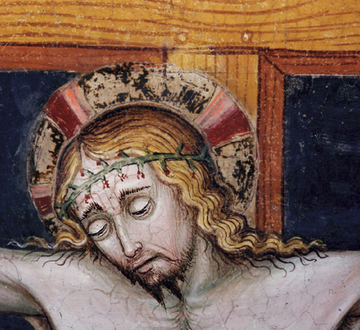Church of St. Maria in Strada, Monza (MB)
Via Italia, 20 20052 Monza (MB)
The XIV century frescoes in St. Maria in Strada. Restoration works
The restoration works carried out by Anna Lucchini’s company was completed in 1999. The frescoes depicting the Crucifixion and the Annunciation showed signs of degradation including clear signs of rising damp which was visible on the walls of the chapel. The major damages - on the eastern wall with a representation of the Annunciation - were due to the opening of a window that connected the apartment of the parish priest on the first floor with the chapel.
This intervention resulted in the loss of most part of Archangel Gabriele. The southern wall of the Crucifixion had been tampered in ancient times - as it is evident in the lower part that is incomplete. After the cutting of the masonry, some detachments occurred showing a part of underpainting with the preparatory drawing of an arm of the Maddalena, traced in red and yellow ocher. The painting technique used for the Crucifixion is the fresco . The preliminary sketch was drawn on more rough plaster, using red and yellow ocher and the painting was completed in six days. The characters reveal the use of verdaccio and morellone. The painting was done with tempera colors diluted into an organic binder; the halos and the goblets are punched and engraved , but only a few fragments of the original gilding remain. Even the remains of the paintings on the eastern wall reveal that they were completed in six days. During the restoration the sinopia of another fourteenth-century Crucifixion was found, probably sketched on the minor wall, but then painted on the main one. The restoration works were carried out starting from the elimination of the surface deposits with a preparatory cleaning followed by the cleaning itself. After consolidation of the crumbling plasters, the old stucco works were replaced by others made of appropriate materials. The salts were eliminated through absorbent compresses, and the sinopia was cleaned by removing the carbonation deposits that did not allow its vies. The integration of painting was carried out at the end of all operations. The "Madonna and Announcing Angel" appeared as two fragments of fresco torn off from the façade of Santa Maria in Strada and preserved, after ripping, in the sacristy. The paintings - affected by degrading phenomena caused by rainwater - were made with the technique of fresco, with finishing touches using colors diluted in a medium on a dry plaster. The background and the halos as well were designed as an elegant damask obtained with gold embossed tablet. The two paintings were cleaned by solid deposits and gold areas protected with a high concentration of Paraloid B72, removed after cleaning. After deleting the old plasters, the paintings were made to adhere to new supports in fiberglass. Finally the grouting of the incomplete areas and the restoration of paintings concluded the works.
By Anna Lucchini


















